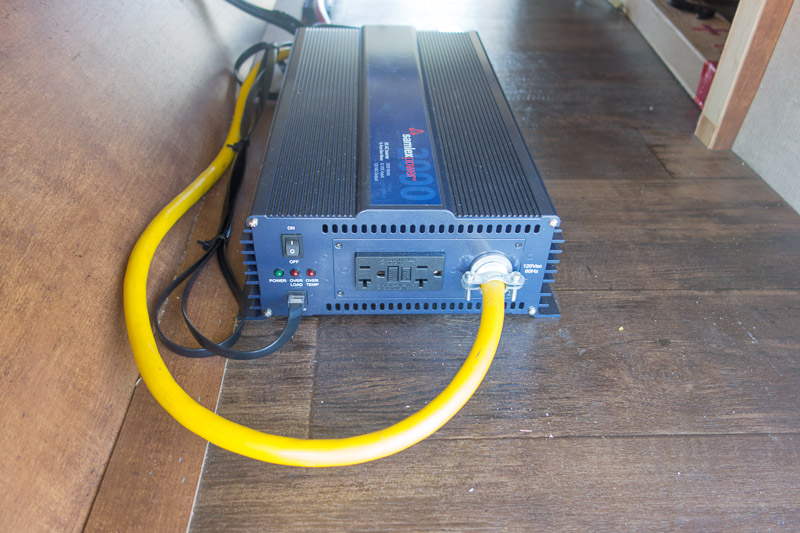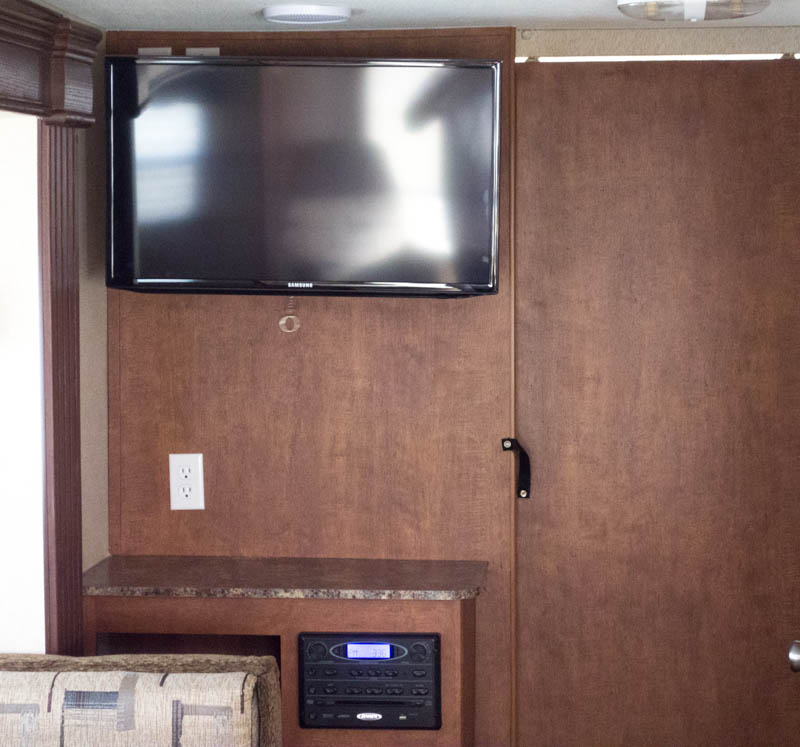
Ah, perpetual energy without solar panels or a generator!
Readers of this website normally can’t contact me, because there isn’t a “Comments” function, nor is there an “Email” button. But hey, this is the Internet Age, and it shouldn’t be too difficult to contact me if one really wants to. Then of course, it is more than likely I will ignore you. However, in this case, I recently received an interesting inquiry worth discussing.
Hi Nick,
I read your posts on solar and batteries and have a question. Why can’t I just connect an inverter to my trailer’s battery and then power a battery charger with the inverter. Seems the battery would always be 100% charged.
Not only is the answer, “No,” but trying to do this will cause a battery to go dead very quickly. There are two ways to explain this. The first is by using some simple math, and the second is to experiment under real-world conditions. I’ll do both. Before we start, we need to define a couple terms.

Inverter: a device that changes direct current (DC) into alternating current (AC). For most of us, we would connect an inverter to a 12 volt DC source (your car or RV battery) that would allow the use of household 120 volt AC appliances, such as a television, toaster, computer, etc.

Converter: Most RV’s come with a converter. What this does, when you plug the RV into a 120 volt source, is distributes 120 volt power to the household type electrical outlets and, at the same time, converts some of the power to 12 volts DC to operate any 12 volt items, such as overhead lights or the water pump. Today most converters come with a battery charger built in to re-charge the 12 volt battery.

When the trailer is connected to 120 volts AC, then the air conditioner, microwave, and 120 volt outlets (like those in your house) can be used. At the top of the converter you will see 8 household type circuit breakers. These are for the 120 volt system. Going from left to right, you will see a 30 amp breaker, which is the main power in. The other seven breakers run the different 120 volt circuits. The two 20 volt breakers that run the air conditioner and microwave are switched OFF because we never use them. The very last breaker on the right (15 amp), the breaker that powers the battery charger, is also OFF.
Notice the bank of colored 12 volt fuses on the left. Some things in the trailer always run on 12 volts DC, such as the lights, water pump, refrigerator circuitry, slide-out room motor, and water heater ignitor. If the trailer isn’t connected to a 120 volt source, then the trailer’s 12 volt battery runs these things. If the trailer is connected a 120 volt source, then it sends 12 volts DC to the circuits powered by the colored fuses and it will also charge the 12 volt battery.
Watt’s Law
My kids are probably thinking, dang here he goes with the “math is your friend” thing again!
Watts is the measure of electrical energy consumed or generated. This law tells us that watts are the relationship of amps and voltage in a circuit. Now let’s consider the typical battery charger that runs on 120 volts.
Most battery chargers consume 3 to 5 amps when hooked up to a 120 volt source, and deliver around 5 amps of 12 volt current to the battery.
If we want to know how many watts it consumes, the formula is:
Watts = Amps X Volts
For our example we will assume our battery charger consumes 3 amps and it is plugged into a household 120 volt wall outlet:
Watts = 3 Amps X 120 Volts
Watts = 360
This tell us that our battery charger consumes 360 watts of electricity.
Now bear with me on this. If we connect an inverter to our battery and plug our charger into it, we are now powering everything from the 12 volt battery.
12 Volt (DC) Battery <—> Inverter <—> 120 Volt (AC) Battery Charger
The charger is still going to consume 360 watts, but the volts and amps have changed. So let’s go back to Watt’s Law and start filling in the unknowns:
Watts = Amps X Volts
360 Watts = ?? Amps X 12 Volts
360 Watts = 30 Amps X 12 Volts
What have we learned about trying to charge a battery using an inverter connected to the battery?
Let’s number the items to consider:
- Our battery has a 30 amp draw on it to power the inverter and battery charger (from the last watts calculation above).
- The battery charger will only return 5 amps back to the battery (remember, earlier we determined most battery chargers will charge at around 5 amps)
- By trying to charge the battery with the inverter we are actually using 25 more amps than we are returning back to the battery (Item 1 minus Item2)
- If we tried to charge our battery For 9 hours we would use 225 Amp Hours (Item 3 times 9 hours; or 25 amps X 9 hours = 225 amp hours)
- Our battery has a total capacity of 225 Amp Hours, so it will be 100% discharged in 9 hours, ASSUMING WE STARTED WITH A FULLY CHARGED BATTERY.
- We don’t want to discharge a deep cycle battery more than 50% of its rated capacity. If we started with a fully charged battery, and connected our inverter and charger to the battery, we would have to disconnect everything after only 4.5 hours, because the battery would be at 50% capacity without powering anything else.
This is just the math. How these electronics work is a bit more complicated, and our calculations do not take several inefficiencies into consideration — meaning in real life things will work out worse over a period of time.

The biggest thing to remember that charging a conventional lead-acid battery isn’t very efficient. We have to use a lot of energy to charge a battery.
We are applying electrical energy from the charger to chemical energy in the battery and this process is losing quite a bit of energy in heat. If you have ever watched a battery charge with the vent caps off, you would have seen the battery acid bubbling… this is heat that is simply lost to the atmosphere.
“Prove It!”
“Okay, Nick,” you say, “I don’t understand all your mumbo-jumbo formulas and theories. Prove it!”
Okay, no problemo.
Step 1
I turned off circuit breakers to the solar panels, and looking at the Tri-Metric battery monitor found the electrical system was discharging (-00.2 amps). This discharge is caused by the propane leak detector and the clock in the entertainment unit.

Step 2
Now I turned on the inverter.

At this point in time, nothing was operating on 120 volts, but the inverter itself uses electricity just by being on. As you can see below, our system is now discharging at a rate of 1.3 amps (-01.3).

Step 3
Next we go inside the camper and switch that last circuit breaker, that powers the battery charger in the converter, to ON and see what happens…

Holy Guacamole!
The system is now using 23.7 amps, which is almost identical to our theoretic math problem! Not only can we not charge our battery, but if we leave it like it is, our (presently) fully charged battery will be dead in just a few hours.